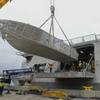A group of 16 Sailors assigned to USS Shoup (DDG 86) got “hands-on” firefighting training at Fremont Maritime Services in Seattle on June 6.
“Our training is designed to supplement the drills already performed on board,” said Capt. Jonathan Kjaeruff, president of Fremont Maritime Services.
“On board a ship, Sailors are trained to be familiar with their gear and the ship layout, but here we set things on fire and show them how to use the different firefighting agents in realistic situations,” he continued.
Realistic scenario drills are important because Sailors need to know how difficult fighting fires can be.
“When the adrenaline gets flowing in real emergencies, people tend to freeze up,” said Kjaeruff. “Our students get to feel the heat, maneuver a charged hose and are trained to stay low. These things can be difficult and any one of these factors can take a Sailor out of the running.”
Cryptologic Technician Maintenance 2nd Class (SW) Alexis Miille said she was able to get real-time experience fighting fire, which was different from the normal damage control training on the ship.
“My favorite part of this training is getting to use the equipment on an actual fire,” said Miille. “Now, we actually see what is supposed to happen when we open the hose. On the ship, we don’t actually get to spray. We just pretend.”
Many Sailors who participated in the training agreed that the training is useful to everyone on board.
“It is quite beneficial for us to have the heat in our faces and realize a low stance is important,” said Ensign Piko Neal. “We also got to see how to use the different agents in different situations. I think everyone benefits from knowing these things, because it is not always up to the damage controlmen to fight the fires.”
Ensign Binh Nguyen said he was proud of the performances from the junior Sailors and is confident that they could step up and handle the situation in the event of a real emergency.
“In emergency situations we have a common goal to save the ship,” said Nguyen. “As an officer, I’m supposed to take charge; but if an airman has more knowledge than me, then he or she is the boss.”
Boatswain’s Mate 1st Class Amy Henry said she has new confidence in her abilities to contribute to a team effort.
“I thought my being small would make it hard for me to participate,” said Henry. “Now I’ve seen us working as a team, I feel like I was able to be a valuable contributor.”
Subscribe for
Maritime Reporter E-News
Maritime Reporter E-News is the maritime industry's largest circulation and most authoritative ENews Service, delivered to your Email five times per week










